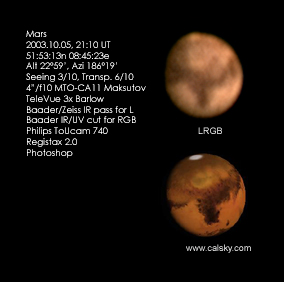
The following images represent my first approaches to planetary webcam imaging. Unfortunately my learning curve in webcam imaging had a quite steep slope ahead during the mars opposition 2003 so that the following images don't represent the best results possible with the equipment used and the atmospheric conditions. I did not use optimal webcam settings (brightness, gamma, saturation) for imaging mars at all so I'm looking forward to the mars opposition 2005 which will feature a somewhat greater distance from earth to mars than 2003 but much more usable altitudes of mars in europe :)
Mars - 2003.10.05 - IR Passfilter Test


Mars 2003.09.03 |
Mars 2003.08.27 |
Mars 2003.08.26 |
Something went terribly wrong. Conditions have been fairly good, seeing allowed up to 500x visually. Some systematic focussing error ruined all AVIs. The result is resized to 40% - no more information in the source files... |
Seeing was quite bad when I started and improved little towards 4:00. Transparency was low, high altitude cloud bands varied mars magnitude a lot. 305 frames of 1400 stacked, only coarse structures are visible, at least the image shows a glimpse of Olympus Mons ( or what I whish to be OM ). |
Firstlight of my Vixen VMC200L. |
My best mars so far. I experimented with several shutter speed, brighness
and saturation settings and received the best results at 1/25s with a
little brighter and more saturated setting than I used in the past. |
Mars 01.08.2003 |
Mars 29.07.2003 After setting up my equipment, taking two first test AVIs, letting my scope cool down and beeing happy that my recently modified controller tracks the mount very well, I've been able to take just one real AVI of mars. Just as I wanted to play with brightness settings my RA-motor went nuts, tracked totally unsteady and way too slow. Grrr, thanks a lot... The result shows an odd overprocessed feature at the top-right rim (south-west area od mars). No idea if this is an overprocessed surface feature or caused somehow my equipment. P.S.: Guess what, my mount tracks accurate again back in the house... |
Mars 19.07.2003 (2) Another image from this session. The two versions of processing show a more natural softer look and a harder version showing more details besides the processing artefacts. |
Mars 19.07.2003 My second attempt to image mars. My new TeleVue 3x barlow performed so much better than the old teleconverter. Here are 4 different versions of processing:
All images feature wavelet processing in Registax with linear layers, initial 1 with 1 step giving great control. Differential atmospheric refraction corrected by upshift about 1 pixel in the blue channel to align color channels. Compared to my first Mars I found a correct setting for the white balance not oversaturating the red channel and giving details in all color channels. |
I reprocessed the below image. More experience with Registax 2.0 helps :)
Mars 15.07.2003 - my first planetary image ever Object: Mars, alt 25°05' |